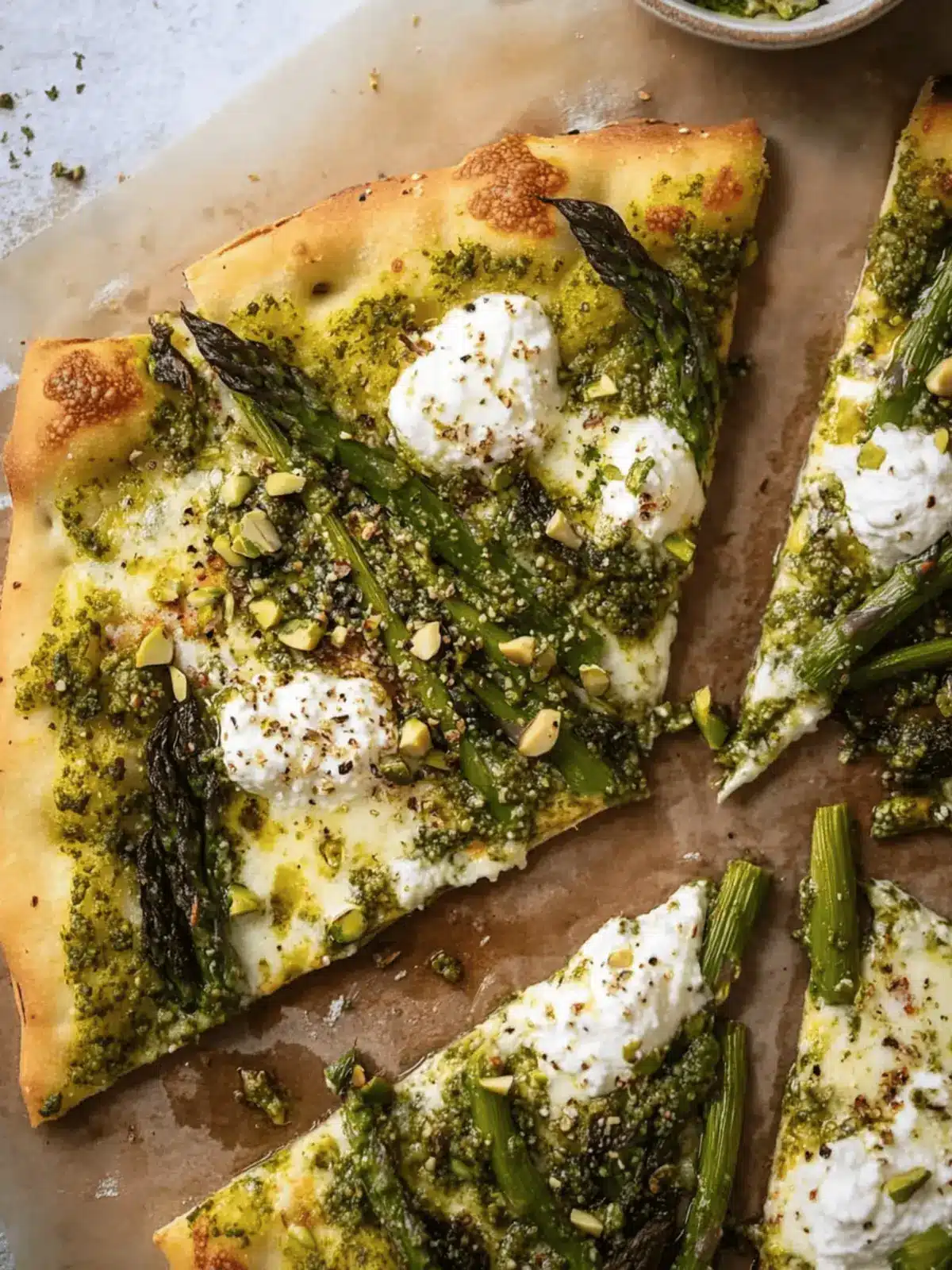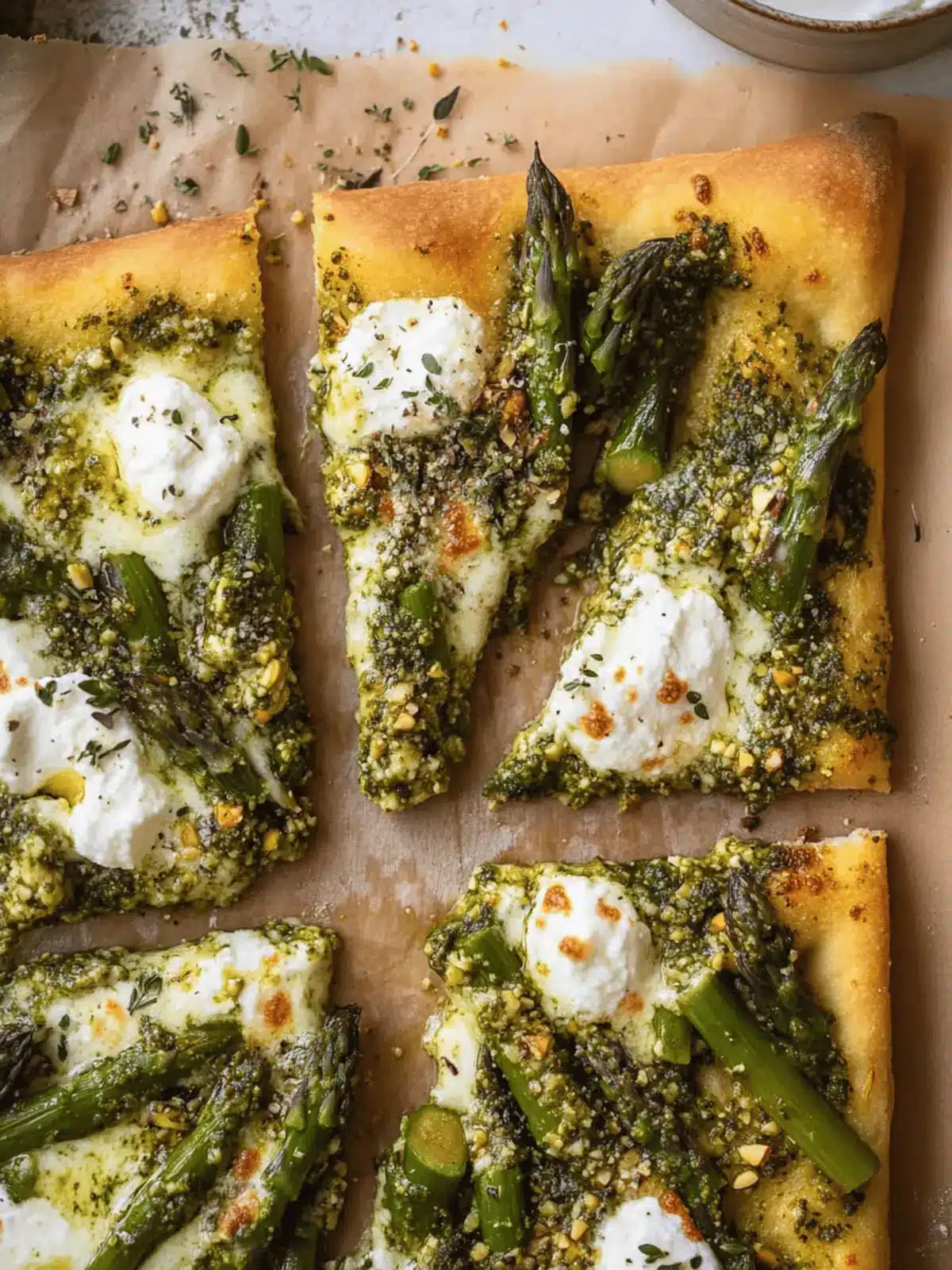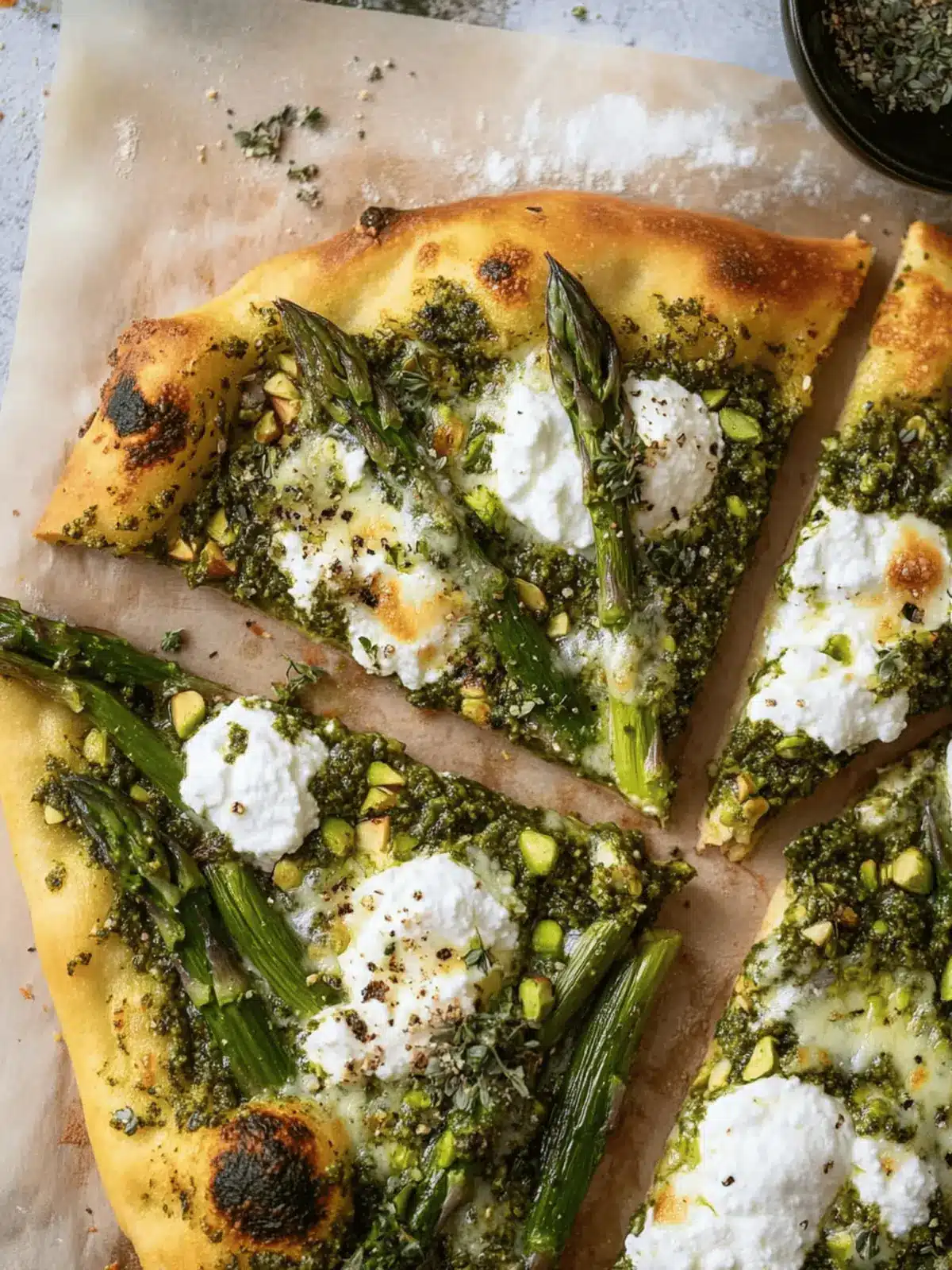As spring blooms, there’s an irresistible urge to celebrate the season with fresh and vibrant dishes. Picture this: the delightful aroma of nutty pistachio pesto mingling with creamy ricotta, a hint of zest from fresh lemons, and the satisfying crunch of tender asparagus—all elegantly arranged atop a golden crust. This Spring Pistachio Pesto Pizza with Asparagus and Ricotta is not just any pizza; it’s a refreshing escape from the mundane and an invitation to embrace the garden’s bounty.
After a long week of fast food indulgences, this pizza offers a light yet hearty alternative that’s sure to impress. With a tantalizing blend of ingredients bursting with the essence of spring, each bite becomes a culinary adventure that tantalizes your taste buds. Whether you’re sharing it with family at the dinner table or savoring it on a sunny afternoon, this dish transforms any casual meal into a joyous celebration of seasonal flavors. Get ready to delight in a culinary creation that’s simple to prepare while exuding elegance—a perfect midweek treat or a show-stopping main course for your next gathering!
Why choose Spring Pistachio Pesto Pizza?
Freshness at Its Best: This pizza showcases the vibrant flavors of spring, using seasonal ingredients that brighten up your plate.
Unique Flavor Profile: The nutty pistachio pesto combined with creamy ricotta and zesty lemon creates an irresistible taste sensation.
Crowd-Pleasing Appeal: Perfect for sharing, this dish transforms any meal into a delightful celebration, winning over vegetarians and meat lovers alike.
Simplicity and Ease: With basic baking skills, you can whip up this pizza effortlessly, making it an ideal choice for busy weeknights.
Versatile Options: Feel free to experiment with seasonal vegetables or cheese substitutes to make it your own. You might also want to check out our guide on nut-free alternatives.
Healthy Indulgence: Packed with greens, this pizza offers a nutritious, hearty option that leaves you feeling satisfied but light.
Spring Pistachio Pesto Pizza Ingredients
For the Dough
• Warm Water – Activates yeast for dough; use lukewarm for best results.
• Active Dry Yeast – Leavening agent that helps dough rise; ensure it’s fresh for effective activation.
• Honey – Adds a hint of sweetness to balance flavors; can substitute with brown sugar.
• Olive Oil – Provides moisture and flavor in the dough; extra virgin is recommended.
• All-purpose Flour – Main structure for the pizza crust; can substitute with gluten-free flour.
• Salt – Enhances overall flavor of the dough; essential for seasoning.
For the Pesto
• Shelled Pistachios – Base for nutty pesto; can substitute with pine nuts for a traditional flavor.
• Fresh Basil Leaves – Adds a fresh, aromatic flavor to the pesto; can use other herbs like parsley if unavailable.
• Garlic Cloves – Infuses the pesto with savory depth; fresh garlic is preferable.
• Lemon Juice – Brightens the pesto flavor; fresh juice is best.
• Pecorino Romano Cheese – Adds saltiness and depth to the pesto; can substitute with parmesan.
• Extra Virgin Olive Oil – For blending the pesto and drizzling over pizza.
• Kosher Salt and Pepper – Seasoning for pesto and final dish to taste.
For the Pizza Toppings
• Ricotta Cheese – Creamy base for the pizza, adds richness; extra ricotta can be used for topping.
• Shredded Cheese (Mozzarella/Provolone/Italian Blend) – Melts well, adds flavor and texture; any blend that melts well can work.
• Fresh Lemons – Use zest for a citrusy aroma; ensures brightness in flavor.
• Asparagus Spears – Provides crunch and a fresh taste; can substitute with broccoli.
• Green Peas – Adds color and sweetness; can use frozen peas if fresh aren’t available.
• Parmesan Cheese – For topping; enhances flavor with salty complexity.
• Arugula or Micro Greens – Fresh toppings to add a peppery note at the end.
This Spring Pistachio Pesto Pizza with Asparagus and Ricotta is a delightful mix of fresh flavors among your homemade pizza offerings! Enjoy!
How to Make Spring Pistachio Pesto Pizza
-
Prepare Dough: In a bowl, combine warm water, yeast, honey, and olive oil. Allow it to foam for about 10 minutes. Next, add flour and salt, kneading until a sticky dough forms.
-
Let Rise: Place the dough in an oiled bowl, cover it, and set it in a warm spot. Let it rise for 1-1.5 hours until it has doubled in size.
-
Make Pesto: In a blender, combine pistachios, basil, garlic, lemon juice, and pecorino. Stream in olive oil until the mixture is smooth, and season with salt and pepper.
-
Preheat Oven: Set your oven to 450°F. Dust a baking sheet with flour or cornmeal to prevent sticking.
-
Shape Dough: Roll out the risen dough on a floured surface until it reaches your desired thickness. Transfer it to the prepared baking sheet.
-
Assemble Pizza: Spread a generous layer of pesto over the dough. Then, add dollops of ricotta, lemon zest, shredded cheese, asparagus, and green peas. Feel free to add more pesto if you wish!
-
Bake: Place the pizza in the oven and bake for 15-20 minutes, or until the crust is golden brown and the cheese is bubbly.
-
Finish: Before serving, top the pizza with extra lemon zest, a sprinkle of Parmesan, and fresh greens for a vibrant touch!
Optional: Garnish with a drizzle of olive oil for added flavor.
Exact quantities are listed in the recipe card below.

Spring Pistachio Pesto Pizza Variations
Embrace your culinary creativity and transform this delightful pizza into your own masterpiece!
- Dairy-Free: Swap ricotta and cheese with vegan alternatives for a creamy, plant-based pizza. You can still enjoy that luscious texture without dairy!
- Nut-Free: Use sunflower seeds or pumpkin seeds in the pesto instead of pistachios. This will give it a unique flair while staying nut-free.
- Herb Swap: Replace basil with arugula or spinach for a peppery twist in the pesto. It adds an extra dimension of flavor that’s refreshing and vibrant.
- Veggie Boost: Add roasted red peppers or sautéed mushrooms as additional toppings for a hearty and flavorful kick. The combination will tantalize your taste buds!
- Extra Zesty: Incorporate lime juice in the pesto for a tropical twist. This brightens the dish and makes it feel even more like spring!
- Cheese Variation: Try goat cheese instead of ricotta for a tangy and rich alternative. Its flavor pairs beautifully with the pesto and adds complexity.
- Spice it Up: Sprinkle some red pepper flakes over the pizza before baking to introduce a delightful heat that complements the other flavors beautifully.
- Grain-Free Crust: For a gluten-free option, use a cauliflower-based crust instead. It provides a unique texture and adds another layer of healthiness to your meal.
Let your imagination roam as you adapt this recipe to suit your preferences!
Tips for the Best Spring Pistachio Pesto Pizza
• Fresh Ingredients Matter: Use the freshest herbs, especially basil, to elevate the flavor of your pesto in the Spring Pistachio Pesto Pizza.
• Perfect Rising: Ensure your dough rises in a warm, draft-free environment; drafts can hinder proper dough expansion.
• Pesto Balance: Be mindful with the quantity of pesto—too much can overwhelm the other flavors; start with a light spread and adjust as needed.
• Baking Crispiness: For a crispier crust, pre-bake the naked dough for 5 minutes before adding toppings; this can prevent sogginess.
• Creative Toppings: Don’t hesitate to experiment! Try using seasonal vegetables like zucchini or swap ricotta for goat cheese for a different twist.
• Easy Reheating: To enjoy leftovers, reheat in the oven instead of a microwave to maintain the crisp texture of your Spring Pistachio Pesto Pizza.
Make Ahead Options
These Spring Pistachio Pesto Pizza with Asparagus and Ricotta are perfect for busy weeknights! You can prepare the dough and pesto up to 24 hours in advance. First, make the dough as directed, let it rise, then wrap it in plastic wrap and refrigerate. The pesto can be made, stored in an airtight container, and refrigerated too. On the day of serving, simply roll out the dough, spread the cold pesto, and assemble your toppings before baking. This approach not only saves time but ensures each bite is just as delicious and fresh. Enjoy a homemade meal with minimal effort on those hectic days!
What to Serve with Spring Pistachio Pesto Pizza?
As the aroma of freshly baked pizza wafts through the air, it’s time to think about what delightful sides will accompany your vibrant creation.
-
Simple Side Salad: A crisp salad with mixed greens, cucumber, and a lemon vinaigrette provides a refreshing contrast to the creamy pizza.
-
Garlic Breadsticks: Soft, buttery breadsticks brushed with garlic and herbs create a delectable pairing that complements the pizza’s flavors.
-
Caprese Skewers: Fresh mozzarella, tomatoes, and basil drizzled with balsamic glaze offer a bright and savory appetizer that heralds the arrival of spring.
-
Roasted Veggies: Sweet, caramelized seasonal vegetables like carrots, bell peppers, and zucchini deliver earthy notes that enhance the freshness of the pizza.
-
Chilled White Wine: A light, crisp Sauvignon Blanc or a gentle Pinot Grigio can elevate your dining experience with subtle acidity that echoes the lemon zest in the pizza.
-
Lemon Sorbet: For dessert, a scoop of zesty lemon sorbet is the perfect palate cleanser, refreshing your senses after the hearty pizza.
Each of these side options beautifully complements the Spring Pistachio Pesto Pizza, creating an uplifting and balanced meal that celebrates the flavors of the season.
How to Store and Freeze Spring Pistachio Pesto Pizza
Fridge: Place leftover pizza in an airtight container and refrigerate for up to 3 days. Reheat in the oven at 350°F for crispy edges.
Freezer: Wrap individual slices in plastic wrap, then aluminum foil, and freeze for up to 1 month. Reheat from frozen at 375°F until heated through.
Room Temperature: It’s best to avoid leaving the pizza out for more than 2 hours to maintain freshness and safety.
Reheating: For the best texture, always reheat in the oven or a toaster oven rather than the microwave. Enjoy your Spring Pistachio Pesto Pizza at its finest!

Spring Pistachio Pesto Pizza with Asparagus and Ricotta Recipe FAQs
What type of pistachios should I use for the pesto?
Absolutely! Opt for unsalted, shelled pistachios to create that delightful nutty flavor without the extra saltiness. Make sure they’re fresh for the best flavor—if you can buy them in bulk, that’s often a good sign of freshness.
How should I store leftover pizza?
To keep your Spring Pistachio Pesto Pizza fresh, place any leftovers in an airtight container in the fridge for up to 3 days. When you’re ready to enjoy it again, reheat it in the oven at 350°F for best texture—this way, you’ll get those delicious crispy edges back!
Can I freeze my pizza?
Definitely! For freezing, wrap individual slices tightly in plastic wrap, then in aluminum foil to prevent freezer burn. It can last up to 1 month. When you’re ready to eat, reheat straight from the freezer at 375°F until heated through.
What if my dough doesn’t rise properly?
If your dough doesn’t rise, it could be due to the yeast being expired or the environment being too cold. Make sure to use lukewarm water (about 110°F) to activate the yeast, and let your dough rise in a warm, draft-free area. If it still doesn’t rise, try again with fresh yeast and ensure the temperature is cozy for your dough.
Are there any dietary considerations I should keep in mind?
Yes! If you’re serving this pizza to guests with specific dietary needs, check for allergies, especially since it contains nuts and dairy. You can substitute the ricotta with dairy-free options if you’re catering to someone with lactose intolerance, and for those avoiding nuts, consider using sunflower seeds in the pesto instead.
What kind of substitutes can I use for asparagus?
If asparagus is not available, feel free to get creative! I often swap in broccoli florets for some added crunch or even zucchini slices for a fresh twist. Just make sure the vegetables you choose are of similar texture to keep the pizza enjoyable.

Spring Pistachio Pesto Pizza with Asparagus and Ricotta Bliss
Ingredients
Equipment
Method
- In a bowl, combine warm water, yeast, honey, and olive oil. Allow it to foam for about 10 minutes. Then, add flour and salt, kneading until a sticky dough forms.
- Place the dough in an oiled bowl, cover it, and set it in a warm spot. Let it rise for 1-1.5 hours until doubled in size.
- In a blender, combine pistachios, basil, garlic, lemon juice, and pecorino. Stream in olive oil until smooth, seasoning with salt and pepper.
- Preheat oven to 450°F. Dust a baking sheet with flour or cornmeal to prevent sticking.
- Roll out the risen dough on a floured surface to your desired thickness, then transfer to the prepared baking sheet.
- Spread a generous layer of pesto over the dough. Add dollops of ricotta, lemon zest, shredded cheese, asparagus, and green peas. Add more pesto if desired!
- Bake for 15-20 minutes, or until crust is golden and cheese is bubbly.
- Top with extra lemon zest, a sprinkle of Parmesan, and fresh greens before serving!






